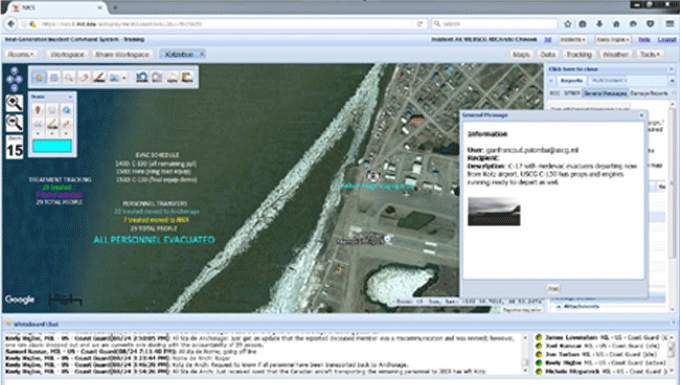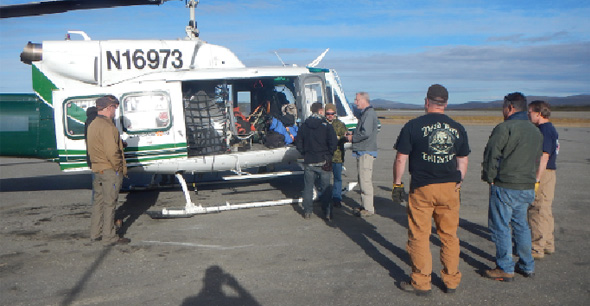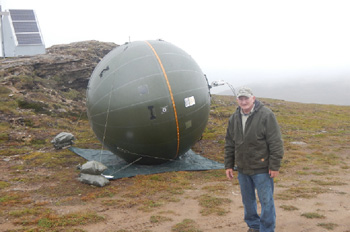Photo Journal: RDC Arctic Technology Evaluation 2016
The Coast Guard Research and Development Center is participating in an Arctic search and rescue exercise called Arctic Chinook in Alaska Aug. 22-24. During the exercise, the RDC will test new communications equipment and disaster response technologies to improve the Coast Guard's ability to provide rescue assistance in the Arctic Circle. Photos and progress updates on Arctic Chinook will be posted here daily during the exercise.
Coast Guard Completes Arctic Chinook Training Exercise

The Coast Guard successfully completed the Arctic Chinook search and rescue exercise Aug. 23-24 with the cooperation of the Royal Canadian Air Force and the Alaska National Guard. During Arctic Chinook, Coast Guard Cutter Alex Haley simulated a catastrophic event on a cruise ship forcing 250 crew and passengers to abandon ship in a secluded part of Alaska. The Coast Guard Research and Development Center was able to test the Next Generation Incident Command System, a web-based tool that helps organize response efforts. NICS tracks rescue assets, allows command posts to chat with responders in the field and provides updated information to guide decision-making. “We were able to feed command centers with more timely information than they were receiving through traditional methods, and they had a better overall picture of what was happening,” said Lt. Joseph DiRenzo, a program manager in the RDC’s surface branch. U.S. Coast Guard photo.
Coast Guard Flies Replacement Troposcatter To Port Clarence

The Coast Guard transported a replacement troposcatter system by helicopter to Port Clarence, Alaska, Aug. 23. High winds ripped the original system from its base the night of Aug. 21, and the team members returned the following day to find the radio dish damaged beyond repair. They are installing the replacement troposcatter system on the ground instead of on the rooftop site to minimize the effect of wind. The troposcatter system will transmit radio communications between command posts and field sites during the Arctic Chinook search and rescue exercise. U.S. Coast Guard photo.
Arctic Chinook Exercise Relocated

The Coast Guard opted Aug. 22 to move the field test site for the Arctic Chinook search and rescue exercise from Tin City to Kotzebue, Alaska, due to maritime safety concerns from predicted high winds. “The choices were to delay 24 hours for more favorable weather at Tin City or move the exercise to a location five miles outside of Kotzebue to a radar field where the weather is predicted to be more favorable,” said Lt. Cmdr. Sam Nassar, the project manager overseeing the communications testing during Arctic Chinook. The relocation “is an opportunity to truly test rapid deployability,” he added. The team will still run a communications test from the original location at Tin City if weather permits. U.S. Coast Guard photo.
Coast Guard Deploys Inflatable Satellite Dish To Provide Arctic Internet

The Coast Guard Research and Development Center and representatives from GATR Technologies deployed an inflatable Ku band satellite dish on Anvil Mountain near Nome, Alaska, Aug. 21 that will provide internet access to remote locations in Alaska during the Arctic Chinook search and rescue exercise. The RDC also set up a digital troposcatter system that will transmit signals to and from the on-site command post for the exercise. U.S. Coast Guard photo.
Coast Guard Installs Rooftop Radio System

The Coast Guard Research and Development Center and personnel from ComTech Communications installed a rooftop radio system Aug. 20 in Port Clarence, Alaska. The system is part of a network that can transmit voice and data signals over distances up to 48 miles and will provide responders with important cellphone coverage during the Arctic Chinook search and rescue exercise. The RDC will test a mobile version of the Next Generation Incident Command System, a disaster response organization tool that can be downloaded to any computer or smartphone. U.S. Coast Guard photo.
Equipment Setup Continues In Preparation For Arctic Chinook

Coast Guard personnel unloaded and set up over 2,000 pounds of equipment, including a digital troposcatter system, in Port Clarence, Alaska, Aug. 18. The digital troposcatter system will provide extended radio range for rescuers during the Arctic Chinook search and rescue exercise. In order to maximize its range, the Coast Guard fixed the system to the underbelly of a helicopter and flew it to the top of a building where it was installed. U.S. Coast Guard photo.
RDC Deploys Mobile Radio Transmitter To Support Arctic Chinook

The Coast Guard Research and Development Center deployed a mobile line-of-sight radio transmitter in Nome, Alaska, Aug. 17, 2016, that will provide internet connections to disaster response command posts during a search and rescue exercise in remote areas of the Arctic. The exercise, called Arctic Chinook, will take place Aug. 22-24 and will simulate a cruise ship evacuation along the Alaskan coast. U.S. Coast Guard photos.